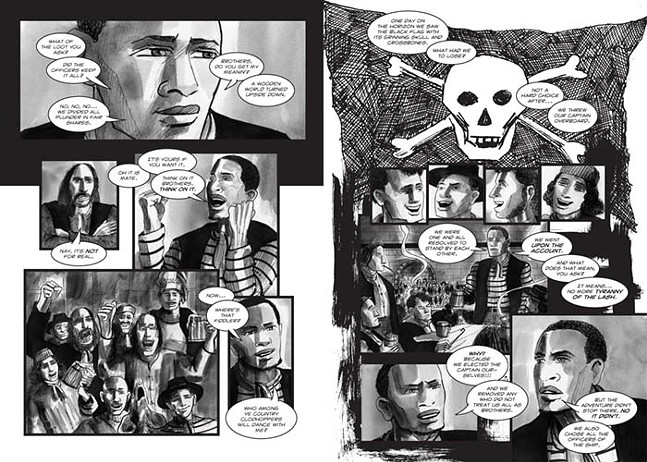It’s not hard to picture a pirate: grizzled, peg-legged, maybe with Jack Sparrow charm and wit. But could these motley crews from the 17th and 18th centuries mean something greater for our understanding of on-land politics? Marcus Rediker and David Lester’s new graphic novel, Under the Banner of King Death: Pirates of the Atlantic, moves beyond the stereotype to show how pirates’ lives provide a template for what democracy could be.
“What you've got among these pirates is a group of poor exploited, working people — in a time when there is no democracy for working people anywhere in the world — coming together to create a multiracial, democratic, social order,” Rediker, a history professor at the University of Pittsburgh, says. “And I find that just remarkable.”
Under the Banner of King Death: Pirates of the Atlantic, released Feb. 7 from Beacon Press, was co-written by Rediker and David Lester, (who also illustrated the book) and edited by Paul Buhle. It’s the second graphic novel collaboration between Rediker and Lester, who previously worked together in 2021 on Prophet Against Slavery, an adaptation of Rediker’s book on the Quaker abolitionist Benjamin Lay.
Under the Banner of King Death is based on Rediker’s 2004 book Villain of all Nations, a historical analysis of the “Golden Age” of piracy, a period from 1660-1730 in which pirates sailed the seas with the most influence, according to Rediker.
The book follows a trio of characters: Ruben Dekker, a seaman from Amsterdam; John Gwin, a Black fugitive from a South Carolina plantation; and Mark/Mary Read, a woman who disguised herself as a man to work on ships. Led by Gwin, the characters endure a set of maritime exploits, from bondage on a slave ship to free pirates on “The Night Rambler” under the infamous skull-and-crossbones “Jolly Roger” flag.
For low-class seamen making their bread and butter on naval fleets, or slaves imprisoned on deep-sea ships, “turning pirate” was often the only reasonable option after a grueling life of back-breaking labor and high-risk living conditions. Piracy was no less of a dangerous profession — a common rallying cry was “a merry life and a short one” — but it was one of their own making, Rediker tells Pittsburgh City Paper.
“The pirate flag said ‘Fuck you,’” Rediker writes in the book’s foreword. “Rage and humor were key elements that characterized these outlaws of the seas: burning anger against the powerful, and the humor of men who chose freedom over servitude at any cost.”
On board a pirate ship, the hierarchy was established through a democratic voting process, and resources were equally distributed amongst the crew, even to those unable to work, Rediker says.
“The pirate captains are all elected, and deposed, if the pirates don't like what they're doing,” Rediker says. “They elect the quartermaster to look after the interests of the crew and they divide up their loot equally. It turns out a very complex social experiment was going on at sea during this time.”
Throughout the book, Rediker and Lester emphasize the daily activities of pirates, from imbibing large amounts of “Kill Devil” (rum) to dancing a jig after overtaking a French ship. Don’t be fooled — these sailors aren’t afraid to send you to Davy Jones’s Locker (the bottom of the sea), but Lester’s drawings humanize the “scaly fish” (seamen) beyond their depictions in popular culture.
Lester chose to illustrate the book in harsh black and white, tinging the late-night tavern scenes and depictions of combat with gravity and aggression.
“[I’m] trying to give that visceral sense to the reader that they are somewhere else. They are not divorced from the history that they are reading because it's not in color,” Lester tells City Paper. “It's not gloss-ified in a certain way.”
Through its illustrations, Under the Banner of King Death captures a personal,up-close view of pirates, an approach that Rediker calls “history from below.”
“The point is to get as close as you can to the historical subjects, to try to grasp their experience, try to grasp their consciousness, try to grasp their forms of resistance, and also, where you can, to recover the voices of these people,” Rediker says.
The threat of the gallows looms large for the characters in the book, but these marauders remain defiantly transgressive till their last breath. As Gwin puts it in the book, sometimes the only remedy for tyranny is “rum . . . and gunpowder.”
“You know, we talk about Thomas Jefferson and the history of democracy — Thomas Jefferson was a slave owner. What we're talking about in this book is real democracy from below,” Rediker tells CP. “And that can be inspiring to people present. You can take a look at this and say, yeah, maybe we can get some ideas for how to organize a better world.”




















